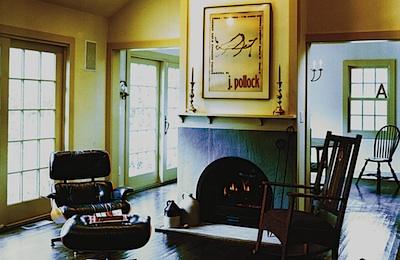Want to Sit by the Fire? Consider Gas by Mike Tagliavia

It’s a wonderful time of year on the East End. A quintessential day can include a winter beach walk and an afternoon before a blazing fire. For the most part, the love of nature and a real crackling fire has trumped local interest in gas fireplaces. But, slowly, house by house, a conversion is happening. Unlike Colorado, we do not have a code banning wood-burning fireplaces. Yet.
Over time, a wood-burning fireplace, once a hierarchical architectural element in a house, essential for survival and primary for cooking and heat, was surpassed by central heating and 60-inch, flat-screen televisions. Building a fire involved physical work and preparation. Today, gas fireplaces offer efficient alternatives. They have become design elements for any style of architecture.
Here are a few different ways gas fires have been implemented.
If you have a wood-burning fireplace and a masonry chimney, you can install a gas line and gas logs without a problem. This allows you to have an authentic or historical mantel and fireplace with an on-and-off switch for the fire. Sounds easy, right?
If you are building a new fireplace, you can choose to build such a chimney and firebox even though you intend to use gas. This would allow you to retrofit the fireplace for wood-burning at a later date.
If cost is an issue, you can build a wood-framed box (no concrete or masonry) into which a metal fireplace housing fits. These units come with or without a chimney, or duct. Such units are typically vented through the roof in a 6 or 8-inch cylindrical duct, but there are non-venting units, which tend to be more modern in style and many are rated for New York City apartments as well.
If you are buying a firebox gas unit you can add various elements. If you want the gas logs to have a traditional wood aesthetic, there are several ceramic or concrete molds that create the appearance of high definition bark. For a more contemporary look there is the option of using fire beads or glass or stones. They come in a variety of colors and styles and give off a reflective glow.
Many of these units actually give off significant heat. This can be direct heating within the room or a supplemental heating source for the entire house. Transferring the heat generated around the firebox requires a fan system, which pushes the air to the desired rooms through ducts. Today, technology makes it possible to have a fireplace in any room in any house.
The best part of a gas fireplace? One answer may be a lower carbon footprint. The other answer? No more ash cleanup or risk of fire from burning embers!
—
Mike Tagliavia is an apprentice architect in East Hampton, working 60 hours a week when he can and loving every minute of it.
